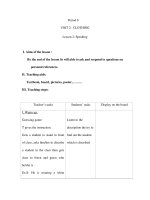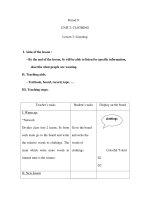The witches by roald dahl
Bạn đang xem bản rút gọn của tài liệu. Xem và tải ngay bản đầy đủ của tài liệu tại đây (446.08 KB, 186 trang )
1
Roald Dahl
THE WITCHES
Copyright © Roald Dahl, 1983
__________
NOTICE
:
This
is
copyright
material.
This
eBook
was
for
my
personal
archive
use
only,
as
provided
under
the
"fair
use"
provision
of
the
Copyright
Law.
If
you
somehow
got
hold
of
this
eBook
file,
by
whatever
means,
and
you
do
not
own
a
copy
of
the
original
book,
please
delete
this
file
immediately.
I
will
not
be
held
responsible
for
your
actions
after
you
have
been
properly
advised.
-
EBOOKS SOS
-
__________
2
A Note about Witches
In fairy-tales, witches always wear silly black hats and
black cloaks, and they ride on broomsticks.
But this is not a fairy-tale. This is about REAL
WITCHES.
The most important thing you should know about REAL
WITCHES is this. Listen very carefully. Never forget
what is coming next.
REAL WITCHES dress in ordinary clothes and look
very much like ordinary women. They live in ordinary
houses and they work in ORDINARY JOBS.
That is why they are so hard to catch.
A REAL WITCH hates children with a red-hot sizz-ling
hatred that is more sizzling and red-hot than any hatred
you could possibly imagine.
A REAL WITCH spends all her time plotting to get rid
of the children in her particular territory. Her passion is
to do away with them, one by one. It is all she thinks
about the whole day long. Even if she is working as a
cashier in a supermarket or typing letters for a
businessman or driving round in a fancy car (and she
could be doing any of these things), her mind will
3
always be plotting and scheming and churning and
burning and whiz-zing and phizzing with murderous
bloodthirsty thoughts.
"Which child," she says to herself all day long, "exactly
which child shall I choose for my next squelching?"
A REAL WITCH gets the same pleasure from
squel-ching a child asyou get from eating a plateful of
strawberries and thick cream.
She reckons on doing away with one child a week.
Anything less than that and she becomes grumpy.
One child a week is fifty-two a year.
Squish them and squiggle them and make them
disappear.
That is the motto of all witches.
Very carefully a victim is chosen. Then the witch stalks
the wretched child like a hunter stalking a little bird in
the forest. She treads softly. She moves quietly. She
gets closer and closer. Then at last, when everything is
ready phwisst! and she swoops! Sparks fly. Flames
leap. Oil boils. Rats howl. Skin shrivels. And the child
dis-appears.
A witch, you must understand, does not knock children
on the head or stick knives into them or shoot at them
4
with a pistol. People who do those things get caught by
the police.
A witch never gets caught. Don't forget that she has
magic in her fingers and devilry dancing in her blood.
She can make stones jump about like frogs and she
can make tongues of flame go flickering across the
surface of the water.
These magic powers are very frightening.
Luckily, there are not a great number of REAL
WITCHES in the world today. But there are still quite
enough to make you nervous. In England, there are
probably about one hundred of them altogether. Some
countries have more, others have not quite so many.
No country in the world is completely free from
WITCHES.
A witch is always a woman.
I do not wish to speak badly about women. Most
women are lovely. But the fact remains that all
witchesare women. There is no such thing as a male
witch.
On the other hand, a ghoul is always a male. So
indeed is a barghest. Both are dangerous. Bu neither of
them is half as dangerous as a REAL WITCH.
As far as children are concerned, a REAL WITCH is
5
easily the most dangerous of all the living crea-tures on
earth. What makes her doubly dangerous is the fact
that she doesn'tlook dangerous. Even when you know
all the secrets (you will hear about those in a minute),
you can still never be quite sure whether it is a witch
you are gazing at or just a kind lady. If a tiger were able
to make himself look like a large dog with a waggy tail,
you would probably go up and pat him on the head. And
that would be the end of you. It is the same with
witches. They all look like nice ladies.
Kindly examine the picture opposite. Which lady is the
witch? That is a difficult question, but it is one that every
child must try to answer.
For all you know, a witch might be living next door to
you right now.
Or she might be the woman with the bright eyes who
sat opposite you on the bus this morning.
She might be the lady with the dazzling smile who
offered you a sweet from a white paper bag in the street
before lunch.
She might even and this will make you jump she
might even be your lovely school-teacher who is
reading these words to you at this very moment. Look
carefully at that teacher. Perhaps she is smiling at the
absurdity of such a sugges-tion. Don't let that put you
off. It could be part of her cleverness.
6
I am not, of course, telling you for one second that your
teacher actually is a witch. All I am saying is that
shemight be one. It is most unlikely. But and here
comes the big "but" it is not impossible.
Oh, if only there were a way of telling for sure whether
a woman was a witch or not, then we could round them
all up and put them in the meat grinder. Unhappily,
there is no such way. But thereare a number of little
signals you can look out for, little quirky habits that all
witches have in common, and if you know about these,
if you remember them always, then you might just
poss-ibly manage to escape from being squelched
before you are very much older.
My Grandmother
I myself had two separate encounters with witches
before I was eight years old. From the first I escaped
unharmed, but on the second occasion I was not so
lucky. Things happened to me that will probably make
you scream when you read about them. That can't be
helped. The truth must be told. The fact that I am still
here and able to speak to you (however peculiar I may
7
look) is due entirely to my wonderful grandmother.
My grandmother was Norwegian. The Nor-wegians
know all about witches, for Norway, with its black
forests and icy mountains, is where the first witches
came from. My father and my mother were also
Norwegian, but because my father had a business in
England, I had been born there and had lived there and
had started going to an English school. Twice a year, at
Christmas and in the sum-mer, we went back to Norway
to visit my grand-mother. This old lady, as far as I could
gather, was just about the only surviving relative we had
on either side of our family. She was my mother's
mother and I absolutely adored her. When she and I
were together we spoke in either Norwegian or in
English. It didn't matter which. We were equally fluent in
both languages, and I have to admit that I felt closer to
her than to my mother.
Soon after my seventh birthday, my parents took me as
usual to spend Christmas with my grandmother in
Norway. And it was over there, while my father and
mother and I were driving in icy weather just north of
Oslo, that our car skidded off the road and went
tumbling down into a rocky ravine. My parents were
killed. I was firmly strap-ped into the back seat and
received only a cut on the forehead.
I won't go into the horrors of that terrible afternoon. I
still get the shivers when I think about it. I finished up, of
course, back in my grandmother's house with her arms
8
around me tight and both of us crying the whole night
long.
"What are we going to do now?" I asked her through
the tears.
"You will stay here with me," she said, "and I will look
after you."
"Aren't I going back to England?"
"No," she said. "I could never do that. Heaven shall
take my soul, but Norway shall keep my bones."
The very next day, in order that we might both try to
forget our great sadness, my grandmother started
telling me stories. She was a wonderful story-teller and I
was enthralled by everything she told me. But I didn't
become really excited until she got on to the subject of
witches. She was apparently a great expert on these
creatures and she made it very clear to me that her
witch stories, unlike most of the others, were not
imaginary tales. They were all true. They were
thegospel truth. They were history. Everything she was
tell-ing me about witches had actually happened and I
had better believe it. What was worse, what was far, far
worse, was that witches were still with us. They were all
around us and I had better believe that, too.
"Are youreally being truthful, Grandmamma?Really
andtruly truthful?"
9
"My darling," she said, "you won't last long in this world
if you don't know how to spot a witch when you see
one."
"But you told me that witches look like ordin-ary
women, Grandmamma. So how can I spot them?"
"You must listen to me," my grandmother said. "You
must remember everything I tell you. After that, all you
can do is cross your heart and pray to heaven and hope
for the best."
We were in the big living-room of her house in Oslo
and I was ready for bed. The curtains were never drawn
in that house, and through the win-dows I could see
huge snowflakes falling slowly on to an outside world
that was as black as tar. My grandmother was
tremendously old and wrinkled, with a massive wide
body which was smothered in grey lace. She sat there
majestic in her armchair, filling every inch of it. Not even
a mouse could have squeezed in to sit beside her. I
myself, just seven years old, was crouched on the floor
at her feet, wearing pyjamas, dressing-gown and
slippers.
"You swear you aren't pulling my leg?" I kept saying to
her. "You swear you aren't just pretending?"
"Listen," she said, "I have known no less than five
children who have simply vanished off the face of this
10
earth, never to be seen again. The witches took them."
"I still think you're just trying to frighten me," I said.
"I am trying to make sure you don't go the same way,"
she said. "I love you and I want you to stay with me."
"Tell me about the children who disappeared," I said.
My grandmother was the only grandmother I ever met
who smoked cigars. She lit one now, a long black cigar
that smelt of burning rubber. "The first child I knew who
disappeared", she said, "was called Ranghild Hansen.
Ranghild was about eight at the time, and she was
playing with her little sister on the lawn. Their mother,
who was baking bread in the kitchen, came outside for
a breath of air. 'Where's Ranghild?' she asked.
" 'She went away with the tall lady,' the little sister said.
" 'What tall lady?' the mother said.
" 'The tall lady in white gloves,' the little sister said. 'She
took Ranghild by the hand and led her away.' No one",
my grandmother said, "ever saw Ranghild again."
"Didn't they search for her?" I asked.
"They searched for miles around. Everyone in the town
helped, but they never found her."
11
"What happened to the other four children?" I asked.
"They vanished just as Ranghild did."
"How, Grandmamma? How did they vanish?"
"In every case a strange lady was seen outside the
house, just before it happened."
"But how did they vanish?" I asked.
"The second one was very peculiar," my grand-mother
said. "There was a family called Christian-sen. They
lived up on Holmenkollen, and they had an old oil-
painting in the living room which they were very proud
of. The painting showed some ducks in the yard outside
a farmhouse. There were no people in the painting, just
a flock of ducks on a grassy farmyard and the
farmhouse in the back-ground. It was a large painting
and rather pretty. Well, one day their daughter Solveg
came home from school eating an apple. She said a
nice lady had given it to her on the street. The next
morning little Solveg was not in her bed. The parents
searched everywhere but they couldn't find her. Then all
of a sudden her father shouted, 'There she is! That's
Solveg feeding the ducks!' He was pointing at the oil-
painting, and sure enough Solveg was in it. She was
standing in the farmyard in the act of throwing bread to
the ducks out of a basket. The father rushed up to the
painting and touched her. But that didn't help. She was
simply a part of the painting, just a picture painted on
12
the canvas."
"Didyou ever see that painting, Grandmamma, with the
little girl in it?"
"Many times," my grandmother said. "And the peculiar
thing was that little Solveg kept changing her position in
the picture. One day she would actually be inside the
farmhouse and you could see her face looking out of
the window. Another day she would be far over to the
left with a duck in her arms."
"Did you see her moving in the picture,
Grand-mamma?"
"Nobody did. Wherever she was, whether out-side
feeding the ducks or inside looking out of the window,
she was always motionless, just a figure painted in oils.
It was all very odd," my grand-mother said. "Very odd
indeed. And what was most odd of all was that as the
years went by, she kept growing older in the picture. In
ten years, the small girl had become a young woman. In
thirty years, she was middle-aged. Then all at once,
fifty-four years after it all happened, she disappeared
from the picture altogether."
"You mean she died?" I said.
"Who knows?" my grandmother said. "Some very
mysterious things go on in the world of witches."
13
"That's two you've told me about," I said.
"What happened to the third one?"
"The third one was little Birgit Svenson," my
grandmother said. "She lived just across the road from
us. One day she started growing feathers all over her
body. Within a month, she had turned into a large white
chicken. Her parents kept her for years in a pen in the
garden. She even laid eggs."
"What colour eggs?" I said.
"Brown ones," my grandmother said. "Biggest eggs I've
ever seen in my life. Her mother made omelettes out of
them. Delicious they were."
I gazed up at my grandmother who sat there like some
ancient queen on her throne. Her eyes were misty-grey
and they seemed to be looking at something many
miles away. The cigar was the only real thing about her
at that moment, and the smoke it made billowed round
her head in blue clouds.
"But the little girl who became a chicken didn't
disappear?" I said.
"No, not Birgit. She lived on for many years laying her
brown eggs."
"You said all of them disappeared."
14
"I made a mistake," my grandmother said. "I am getting
old. I can't remember everything."
"What happened to the fourth child?" I asked.
"The fourth was a boy called Harald, " my
grand-mother said. "One morning his skin went all
greyish-yellow. Then it became hard and crackly, like
the shell of a nut. By evening, the boy had turned to
stone."
"Stone?" I said. "You mean real stone?"
"Granite," she said. "I'll take you to see him if you like.
They still keep him in the house. He stands in the hall, a
little stone statue. Visitors lean their umbrellas up
against him."
Although I was very young, I was not prepared to
believe everything my grandmother told me. And yet
she spoke with such conviction, with such utter
seriousness, and with never a smile on her face or a
twinkle in her eye, that I found myself beginning to
wonder.
"Go on, Grandmamma," I said.
"You told me there were five altogether. What
happened to the last one?"
15
"Would you like a puff of my cigar?" she said.
"I'm only seven, Grandmamma."
"I don't care what age you are," she said. "You'll never
catch a cold if you smoke cigars."
"What about number five, Grandmamma?"
"Number five", she said, chewing the end of her cigar
as though it were a delicious asparagus, "was rather an
interesting case. A nine-year-old boy called Leif was
summer-holidaying with his family on the fjord, and the
whole family was picnicking and swimming off some
rocks on one of those little islands. Young Leif dived
into the water and his father, who was watching him,
noticed that he stayed under for an unusually long time.
When he came to the surface at last, he wasn't Leif any
more."
"What was he, Grandmamma?"
"He was a porpoise."
"He wasn't! He couldn't have been!"
"He was a lovely young porpoise," she said. "And as
friendly as could be."
"Grandmamma," I said.
16
"Yes, my darling?"
"Did he really and truly turn into a porpoise?"
"Absolutely," she said. "I knew his mother well. She
told me all about it. She told me how Leif the Porpoise
stayed with them all that after-noon giving his brothers
and sisters rides on his back. They had a wonderful
time. Then he waved a flipper at them and swam away,
never to be seen again."
"But Grandmamma," I said, "how did they know that
the porpoise was actually Leif?"
"He talked to them," my grandmother said. "He laughed
and joked with them all the time he was giving them
rides."
"But wasn't there a most tremendous fuss when this
happened?" I asked.
"Not much," my grandmother said. "You must
remember that here in Norway we are used to that sort
of thing. There are witches everywhere. There's
probably one living in our street this very moment. It's
time you went to bed."
"A witch wouldn't come in through my window in the
night, would she?" I asked, quaking a little.
"No," my grandmother said. "A witch will never do silly
17
things like climbing up drainpipes or breaking into
people's houses. You'll be quite safe in your bed. Come
along. I'll tuck you in."
How to Recognise a Witch
The next evening, after my grandmother had given me
my bath, she took me once again into the living-room
for another story.
"Tonight," the old woman said, "I am going to tell you
how to recognise a witch when you see one."
"Can you always be sure?" I asked.
"No," she said, "you can't. And that's the trouble. But
you can make a pretty good guess."
She was dropping cigar ash all over her lap, and I
hoped she wasn't going to catch on fire before she'd
told me how to recognise a witch.
"In the first place," she said, "a REAL WITCH is certain
always to be wearing gloves when you meet her."
18
"Surely notalways ," I said. "What about in the summer
when it's hot?"
"Even in the summer," my grandmother said. "She has
to. Do you want to know why?"
"Why?" I said.
"Because she doesn't have finger-nails. Instead of
fingernails, she has thin curvy claws, like a cat, and she
wears the gloves to hide them. Mind you, lots of very
respectable women wear gloves, espe-cially in winter,
so this doesn't help you very much."
"Mamma used to wear gloves," I said.
"Not in the house," my grandmother said. "Witches
wear gloves even in the house. They only take them off
when they go to bed."
"How do you know all this, Grandmamma?"
"Don't interrupt," she said. "Just take it all in. The
second thing to remember is that a REAL WITCH is
always bald."
"Bald?" Isaid.
"Bald as a boiled egg," my grandmother said.
I was shocked. There was something indecent about a
19
bald woman. "Why are they bald, Grand-mamma?"
"Don't ask me why," she snapped. "But you can take it
from me that not a single hair grows on a witch's head."
"How horrid!"
"Disgusting," my grandmother said.
"If she's bald, she'll be easy to spot," I said.
"Not at all," my grandmother said. "A REAL WITCH
always wears a wig to hide her baldness. She wears a
first-class wig. And it is almost impossible to tell a really
first-class wig from ordinary hair unless you give it a pull
to see if it comes off."
"Then that's what I'll have to do," I said.
"Don't be foolish," my grandmother said. "You can't go
round pulling at the hair of every lady you meet, even if
sheis wearing gloves. just you try it and see what
happens."
"So that doesn't help much either," I said.
"None of these things is any good on its own," my
grandmother said. "It's only when you put them all
together that they begin to make a little sense. Mind
you," my grandmother went on, "these wigs do cause a
rather serious problem for witches."
20
"What problem, Grandmamma?"
"They make the scalp itch most terribly," she said. "You
see, when an actress wears a wig, or if you or I were to
wear a wig, we would be putting it on over our own hair,
but a witch has to put it straight on to her naked scalp.
And the underneath of a wig is always very rough and
scratchy. It sets up a frightful itch on the bald skin. It
causes nasty sores on the head. Wig-rash, the witches
call it. And it doesn't half itch."
"What other things must I look for to recognise a
witch?" I asked.
"Look for the nose-holes," my grandmother said.
"Witches have slightly larger nose-holes than ordinary
people. The rim of each nose-hole is pink and curvy,
like the rim of a certain kind of sea-shell."
"Why do they have such big nose-holes?" I asked.
"For smelling with," my grandmother said. "A REAL
WITCH has the most amazing powers of smell. She can
actually smell out a child who is standing on the other
side of the street on a pitch-black night."
"She couldn't smell me," I said. "I've just had a bath."
"Oh yes she could," my grandmother said. "The
cleaner you happen to be, the more smelly you are to a
21
witch."
"That can't be true," I said.
"An absolutely clean child gives off the most ghastly
stench to a witch," my grand-mother said. "The dirtier
you are, the less you smell."
"But that doesn't make sense, Grandmamma."
"Oh yes it does," my grandmother said. "It isn't thedirt
that the witch is smelling. It isyou . The smell that drives
a witch mad actually comes right out of your own skin. It
comes oozing out of your skin in waves, and these
waves, stink-waves the witches call them, go floating
through the air and hit the witch right smack in her
nostrils. They send her reeling."
"Now wait a minute, Grandmamma "
"Don't interrupt," she said. "The point is this. When you
haven't washed for a week and your skin is all covered
over with dirt, then quite obviously the stink-waves
cannot come oozing out nearly so strongly."
"I shall never have a bath again," I said.
"Just don't have one too often," my grand-mother said.
"Once a month is quite enough for a sensible child."
It was at moments like these that I loved my
22
grandmother more than ever.
"Grandmamma," I said, "if it's a dark night, how can a
witch smell the difference between a child and a grown-
up?"
"Because grown-ups don't give out stink waves," she
said. "Only children do that."
"But I don'treally give out stink-waves, do I?" I said. "I'm
not giving them out at this very moment, am I?"
"Not to me you aren't," my grandmother said. "To me
you are smelling like raspberries and cream. But to a
witch you would be smelling abso-lutely disgusting."
"What would I be smelling of?" I asked.
"Dogs' droppings," my grandmother said.
I reeled. I was stunned. "Dogs' droppings!"I cried. "I
amnot smelling of dogs' droppings! I don't believe it!
Iwon't believe it!"
"What's more," my grandmother said, speaking with a
touch of relish, "to a witch you'd be smelling offresh
dogs' droppings."
"That simply is not true!" I cried. "I know I am not
smelling of dogs' droppings, stale or fresh!"
23
"There's no point in arguing about it," my grandmother
said. "It's a fact of life."
I was outraged. I simply couldn't bring myself to believe
what my grandmother was telling me.
"So if you see a woman holding her nose as she
passes you in the street," she went on, "that woman
could easily be a witch."
I decided to change the subject. "Tell me what else to
look for in a witch," I said.
"The eyes," my grandmother said. "Look care-fully at
the eyes, because the eyes of a REAL WITCH are
different from yours and mine. Look in the middle of
each eye where there is normally a little black dot. If
she is a witch, the black dot will keep changing colour,
and you will see fire and you will see ice dancing right in
the very centre of the coloured dot. It will send shivers
running all over your skin."
My grandmother leant back in her chair and sucked
away contentedly at her foul black cigar. I squatted on
the floor, staring up at her, fascinated. She was not
smiling. She looked deadly serious.
"Are there other things?" I asked her.
"Of course there are other things," my grand-mother
said. "You don't seem to understand that witches are
24
not actually women at all. Theylook like women. They
talk like women. And they are able to act like women.
But in actual fact, they are totally different animals.
They are demons in human shape. That is why they
have claws and bald heads and queer noses and
peculiar eyes, all of which they have to conceal as best
they can from the rest of the world."
"What else is different about them, Grand-mamma?"
"The feet," she said. "Witches never have toes."
"No toes!" I cried. "Then what do they have?"
"They just have feet," my grandmother said. "The feet
have square ends with no toes on them at all."
"Does that make it difficult to walk?" I asked.
"Not at all," my grandmother said. "But it does give
them a problem with their shoes. All ladies like to wear
small rather pointed shoes, but a witch, whose feet are
very wide and square at the ends, has the most awful
job squeezing her feet into those neat little pointed
shoes."
"Why doesn't she wear wide comfy shoes with square
ends?" I asked.
"She dare not," my grandmother said. "Just as she
hides her baldness with a wig, she must also hide her
25
ugly witch's feet by squeezing them into pretty shoes."
"Isn't that terribly uncomfortable?" I said.
"Extremely uncomfortable," my grandmother said. "But
she has to put up with it."
"If she's wearing ordinary shoes, it won't help me to
recognise her, will it, Grandmamma?"
"I'm afraid it won't," my grandmother said. "You might
possibly see her limping very slightly, but only if you
were watching closely."
"Are those the only differences then, Grand-mamma?"
"There's one more," my grandmother said. "Just one
more."
"What is it, Grandmamma?"
"Their spit is blue."
"Blue!" I cried. "Not blue! Their spit can't beblue !"
"Blue as a bilberry," she said.
"You don't mean it, Grandmamma! Nobody can have
blue spit!"
"Witches can," she said.









